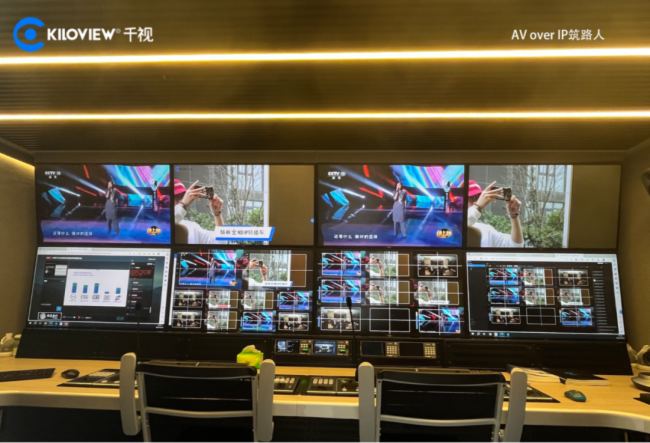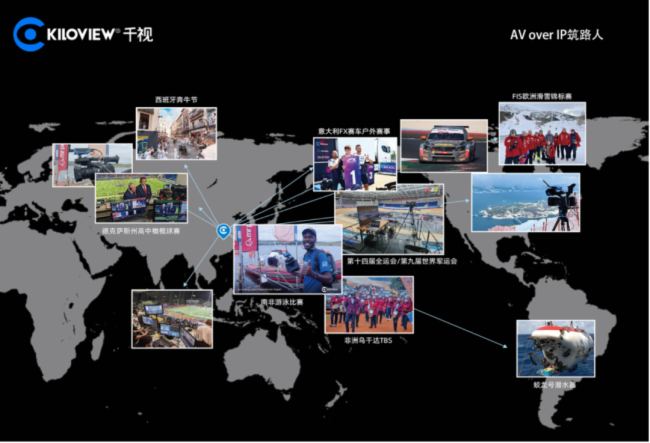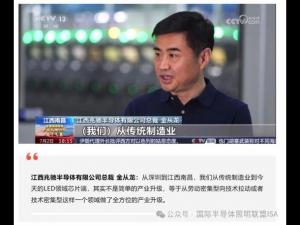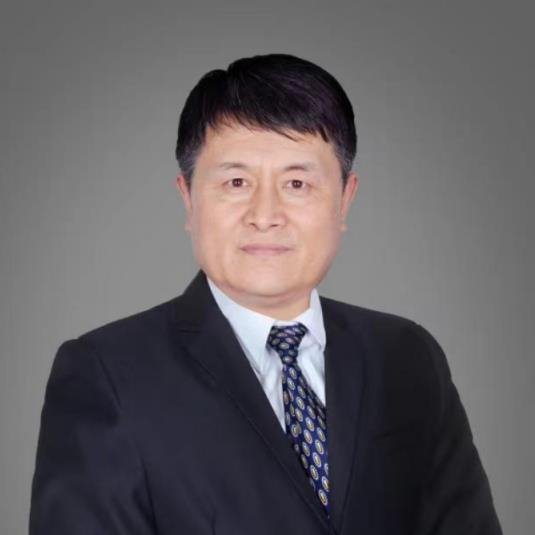Infocomm 2024I Interview with Qianshi Zhang Lei: What changes will IP video transmission lead?
- author:
- 2024-06-06 09:51:55
Qianshi Electronics was founded in 2011 and is a company integrating research and development, production and sales. It focuses on the research and development and innovation of audio and video IP technology. Its products include the entire process of audio and video codec transmission, centralized management, scheduling and distribution, monitoring and recording services. At present, Qianshi Electronics has become one of the fastest-growing companies in the world's AV over IP field. Its comprehensive technical strength and brand influence in the NDI field have firmly ranked among the top three in the world. It is a high-tech enterprise with leading video IP solutions.
What is IP transmission?
IP-based transmission refers to the process of dividing traditional audio and video signals, data and other information into small data packets through the Internet Protocol (IP) network, transmitting them to the target location through the network, and then recombining them into complete information. This transmission method has the characteristics of strong flexibility, good scalability, and low cost, so it has been widely used in many fields such as communications, radio and television, surveillance, distance education, and medical care. Compared with traditional analog transmission, IP-based transmission conforms to the development trend of digitalization and networking, can improve transmission efficiency and quality, reduce costs and complexity, and create more possibilities for information exchange and sharing.
character introduction
Zhang Lei, sales director of Qianshi Electronics. He has worked in-depth in the field of IP transmission for more than ten years, and has extremely rich marketing experience and profound product technology accumulation. For this exhibition, he also carried out an in-depth interpretation of Qianshi's IP transmission strategy. The following is the specific content of the exclusive interview.

Q
1. How to evaluate the status of video IP transmission technology in the current audio and video industry? How does market demand drive the development of video IP transmission technology?
Zhang Lei:
Video IP applications have become the main trend in the development of various industries. Large-scale industries such as media, medical care, conferences, and screen displays have adopted IP technology to solve practical problems. This technology not only realizes the interconnection of various signals, but also fully integrates software and hardware systems to provide more functions while reducing costs.
Video IP services have been widely recognized, and AV over IP has gradually become an application standard in various industries.
The driving needs for the development of IP technology are mainly reflected in the following aspects:
Improvement of video quality: With the development of video from standard definition to high definition to 4K and 8K, traditional baseband transmission links and hardware equipment are difficult to adapt to large-scale, ultra-high-quality video data transmission scenarios, especially long-distance transmission requirements. Therefore, using IP transmission technology, such as video after IP processing and transmission through optical fiber, can ensure audio and video quality while reducing bandwidth pressure, and realize the transmission of multiple channels of audio and video data through one optical fiber.
Development of mobile Internet: Only IP video can break the limitations of time and space and promote the vigorous development of Internet application services. The current global integration process cannot be separated from the support of video IP-based Internet technology.
New functional requirements: As applications in various industries continue to mature and develop, new functional requirements have become prominent. Video IP can give full play to software functions, meet various needs and functions, and promote the perfect integration of software functions and hardware.
Q
2. With the development of video IP transmission technology, which aspects of the professional audio and video industry do you think this has had the greatest impact?
Zhang Lei:
Various fields and vertical industries hope to use audio and video technology to upgrade and transform existing production scenarios to improve efficiency and reduce costs. In this process, only video IP technology solutions can truly fit major business scenarios, such as new media live broadcasting, digital transformation of various industries, telemedicine, remote conferencing, remote operations, and 5G mobile Internet. As video IP technology and applications continue to mature, the audio and video industry is about to usher in an explosion period.

Q
3. What is the specific application and value of NDI technology in reducing production costs and improving efficiency? What is the far-reaching significance for the development of the industry?
Zhang Lei:
NDI is a lightweight and professional audio and video IP technology. Compared with other IP technologies, it rarely has live broadcast functions. NDI is widely used in various professional industry fields. While providing basic functions with higher efficiency and lower cost, it also provides scarce live broadcast functions for various industries. Specifically, the value of NDI is mainly reflected in the following aspects:
High-quality transmission: NDI provides broadcast-level image quality and is capable of transmitting multiple high-definition and 4K videos in ordinary Gigabit or 10 Gigabit environments. This means that using NDI has lower requirements on the network environment.
Rich and sound ecosystem: As of now, the variety of software and hardware products supporting NDI is the most abundant. When using NDI technology to build systems and solutions, there are various options and a complete business chain, covering all aspects such as transmission, switching, distribution, recording, monitoring, and production. In addition, NDI also provides many free software tools, which have been widely praised by users.
Professional live broadcast function: Live broadcasts are being conducted in all walks of life, such as education, medical care, conferences, sports and other fields. NDI's professional media production function provides users with richer choices, including mid-range, high-end and low-end live production solutions. NDI provides flexible and comprehensive solutions for the live broadcast needs of different industries.
Q
4. From the perspective of globalization, what challenges and opportunities do video IP transmission technology face?
Zhang Lei:
Video IP services are developing rapidly around the world, covering applications in various industries such as remote conferencing, remote collaboration, and media distribution. However, the main challenges currently facing include:
Network interoperability obstacles: There are obstacles to network interoperability between different countries, which affects the transmission and application of transnational audio and video signals. In addition, the infrastructure of some countries still needs to be improved, such as insufficient bandwidth and limited public IP, which have also restricted the development of video IP applications to a certain extent.
User perception and security risks: Video IP has become a new technology and new application. When compared with traditional baseband transmission, users generally believe that IP-based services are invisible, have security risks, and are complex in operation management. It takes a certain amount of time for users to learn and accept IP network knowledge. At the same time, as an IP-based product manufacturer, it is necessary to provide a more convenient and visual interactive interface to improve user experience and acceptance.
Different regional requirements: Different countries have different requirements for video IP performance. Some countries focus on transmission security and stability, some focus on flexibility, economy and practicality, some focus on information security, while others focus on other professional performances such as no delay, frame synchronization, etc. This places higher requirements on the products and solutions of IP-based manufacturers, and needs to be continuously improved to meet the core needs of customers in various regions.
Q
5. Considering the rapid changes in technology and markets, how does Qianshi Electronics predict and prepare for future trends in the industry?
Zhang Lei:
Qianshi Electronics has been focusing on video IP business for more than ten years since its establishment, and has accumulated rich experience and technical strength during this period. We are currently able to provide users with complete audio and video solutions, and provide partners with a variety of software and hardware products to adapt to different needs. AV over IP technology has been promoted in an orderly manner in various major industries. Qianshi Electronics actively participates in various industry exhibitions, technical exchanges and other market promotion activities, and deeply participates in the construction of industry cases. At present, we have built a number of typical cases in the media, conference, medical, theater and other industries, and continue to improve products and solutions based on customer needs. At the same time, we continue to optimize product quality and are committed to providing professional and cost-effective products to the market. Through cooperation with powerful manufacturers around the world, we allow users to use our products with confidence and have won a good market reputation.

Q
6. What are the display control products that AMD cooperates with? Why choose AMD?
Zhang Lei:
We are honored to have in-depth cooperation with AMD, which has injected strong performance guarantees and quality guarantees into our products. As video resolution increases from HD to 4K or 8K, video codec performance requirements are growing exponentially. In this context, AMD Zynq UltraScale+ MPSoC provides strong support for solving the technical, cost, power consumption and other challenges of embedded NDI codecs.
AMD Zynq UltraScale+ MPSoC has unique programmable logic (PL) features that not only provide high-level software and hardware reconfiguration and parallel computing functions, but also have a higher-frequency internal running clock, allowing it to utilize fewer logic resources. In addition, Zynq UltraScale+
TAG:
Guess you want to see it
Popular information
-
Interview with Mr. Jin Conglong, President of Zhaochi Semiconductor: A shining star leading the semi

-
Interview with 52DP Youping.com: Conversation with Dipli Rawat, Head of Human Resources in India, Ba

-
Interview with 52DP Youping.com: Pete's colorful career in Barco

-
Interview with 52DP Youscreen website: Future insights into visualization technology--Interview with

-
Infocomm 2024I Interview with Qianshi Zhang Lei: What changes will IP video transmission lead?

-
Xida Electronics Wang Ruiguang: COB development has returned to rationality

-
Find my mission: Hein's 31-year commitment to Barco's excellent quality

the charts
- Xida Electronics Wang Ruiguang: COB development has returned to rationality
- Infocomm 2024I Interview with Qianshi Zhang Lei: What changes will IP video transmission lead?
- Find my mission: Hein's 31-year commitment to Barco's excellent quality
- Interview with 52DP Youping.com: Pete's colorful career in Barco
- Interview with 52DP Youping.com: Conversation with Dipli Rawat, Head of Human Resources in India, Ba
- Interview with 52DP Youscreen website: Future insights into visualization technology--Interview with
- Interview with Mr. Jin Conglong, President of Zhaochi Semiconductor: A shining star leading the semi